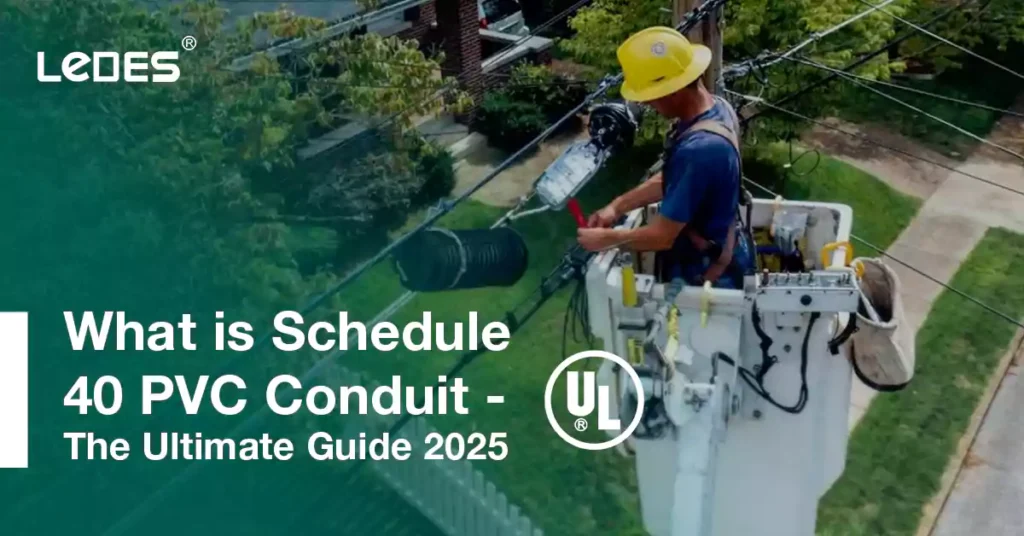
Table of Contents
Electrical conduit systems come in various materials and configurations: metallic (like EMT, IMC, and RMC), non-metallic (such as PVC and HDPE), and flexible types (liquid-tight or corrugated). Each type has distinct properties and is governed by specific codes and performance standards. Among them, Schedule 40 PVC conduit stands out as one of the most popular and versatile options—widely used due to its strength, lightweight nature, affordability, and corrosion resistance.
Choosing the right conduit is essential not only for project efficiency and code compliance but also for long-term safety and performance. A mismatched or non-compliant conduit can lead to costly failures, inspection rejections, or even electrical hazards. In 2025, with evolving standards, green building initiatives, and the growing demand for energy infrastructure (such as EV charging and solar), understanding the right conduit is more important than ever.
In this guide, we’ll explore everything you need to know about Schedule 40 PVC conduit, so you can make informed decisions for any electrical installation project.
What is Schedule 40 PVC Conduit?
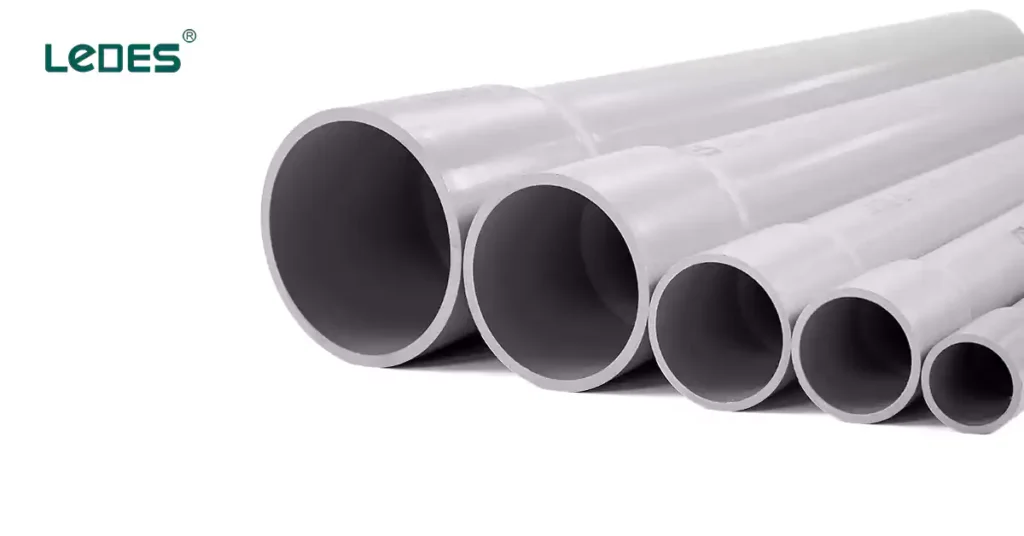
Schedule 40 PVC conduit is a type of rigid, non-metallic electrical conduit made from polyvinyl chloride (PVC) and designed specifically to protect and route electrical wiring. The “Schedule 40” designation refers to its wall thickness, it more broadly reflects durability and mechanical strength.
Schedule 40 electrical conduit is manufactured to meet specific electrical codes and standards, such as UL 651 and NEMA TC-2, which focus on factors like flame resistance, impact strength, and ease of wire pull. It is typically gray in color, signaling its use for electrical applications.
Key Characteristics of Schedule 40 PVC Conduit
Material: Non-metallic, rigid polyvinyl chloride (PVC)
Color: Light gray
Wall Thickness: Moderate—strong enough for underground and exposed use, but lighter than Schedule 80
Flame Resistance: Meets UL flammability standards
Corrosion Resistance: Excellent resistance to most acids, alkalis, salts, and moisture
Insulating Properties: Non-conductive and resistant to electrical currents
Temperature Range: Typically -10°C to 60°C (14°F to 140°F), though varies with formulation
3 Types of Schedule 40 PVC Conduit
While all Schedule 40 PVC conduit shares the same baseline wall thickness and material, manufacturers offer variations to suit different installation needs:
Plain-End Conduit
Straight conduit with unmodified ends.
Requires couplings or solvent cement for joining.
Often used in tight spaces or when cutting and custom-length joins are needed.
Bell-End Conduit
One end of the conduit is factory-formed with a socket (bell) for direct insertion of the next conduit section.
Speeds up installation by eliminating the need for separate couplings.
Ideal for long, continuous runs such as underground installations.
UV-Resistant Formulations
Some Schedule 40 PVC conduit is manufactured with UV stabilizers to prevent degradation from prolonged sun exposure.
Typically marked “UV-resistant” or “sunlight resistant” and compliant with UL 651 requirements for outdoor use.
Recommended for above-ground exterior applications where exposure to sunlight is expected.
Tips: Ledes offer sch 40 conduit for solar power, you can click the link to learn if you are interested.
7 Common Applications of Schedule 40 PVC Conduit
Schedule 40 PVC conduit is known for its versatility, making it a go-to solution for a wide range of electrical wiring installations. Its unique combination of mechanical strength, corrosion resistance, and affordability makes it suitable for use across various residential, commercial, industrial, and infrastructure sectors.
Below are the most common and emerging applications of Schedule 40 PVC conduit:
Residential Electrical Installations
Schedule 40 PVC conduit is frequently used in homes to route wiring for lighting, outlets, HVAC systems, and garage circuits—especially in areas exposed to moisture like basements or exterior walls. It’s also common in underground feeds to detached garages, sheds, or outdoor lighting systems.
Commercial and Institutional Buildings
In commercial settings, such as offices, schools, or healthcare facilities, Schedule 40 PVC is often used to protect branch circuit wiring in slab-on-grade construction, or in underground conduit banks. It is valued for its long lifespan and ease of installation.
- Encased in concrete or buried underground
- Used in power distribution and lighting systems
- Ideal for low-voltage and communication wiring protection
Industrial and Utility Projects
Industrial applications include the conduit’s use in power plants, factories, utility substations, and other applications that without very heavy loads. Schedule 40 PVC is especially suitable in corrosive environments where metal conduit would degrade.
- Excellent resistance to chemicals and moisture
- Used for control wiring, process automation, and sensor networks
- Often combined with expansion fittings to accommodate thermal movement
Solar and Renewable Energy Installations
With the global shift toward clean energy, Schedule 40 PVC conduit plays a vital role in protecting wiring between photovoltaic panels, combiner boxes, inverters, and batteries—especially in ground-mounted solar farms and rooftop systems.
- Frequently used for underground DC/AC feeder cables
- UV-resistant variants ideal for exposed installations
- Lightweight for easy handling during solar field construction
Infrastructure and Transportation
Schedule 40 PVC conduit is widely used in public infrastructure, such as street lighting, highway signage, traffic signal control, and airport runways. Its low cost and ease of installation make it the conduit of choice for large-scale projects.
- Used for underground conduit runs along roads and bridges
- Protects wiring for intelligent traffic systems (ITS)
Data Centers and Communication Systems
As data centers continue to expand in 2025, Schedule 40 PVC conduit is also used to organize and protect communication and fiber optic cabling infrastructure, especially beneath raised floors or in slab installations.
- Provides non-metallic isolation for sensitive cables
- Helps meet separation requirements for power and data
Outdoor and Wet Locations
When paired with proper fittings and weatherproof enclosures, Schedule 40 PVC can be safely used in outdoor and wet environments, such as pool equipment wiring, and marina installations.
- Must be sunlight-resistant for UV exposure
- Often used with watertight junction boxes
- Ensures code compliance in damp locations
Schedule 40 PVC Conduit Code Compliance
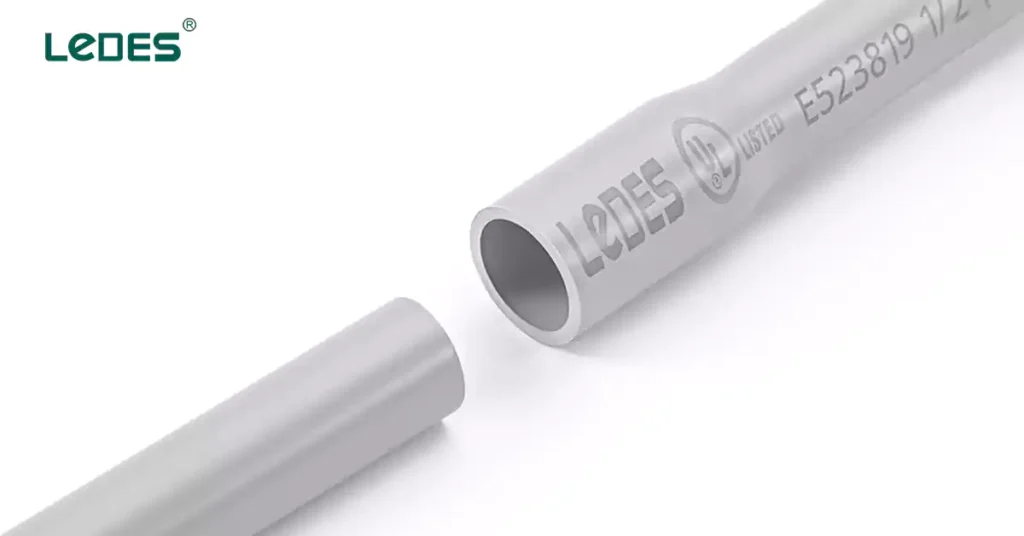
To ensure that Schedule 40 PVC conduit is safe, durable, and suitable for electrical installations, it must comply with several key industry codes and standards. These regulations, developed by national and international organizations, define the minimum requirements for material quality, physical performance, manufacturing consistency, and safe installation. Understanding these standards helps ensure the conduit meets legal requirements, passes inspections, and performs reliably over time.
Here’s a brief look at the major codes and standards that apply to Schedule 40 PVC conduit:
UL 651 – Standard for Schedule 40 and 80 PVC Conduit and Fittings:
UL 651 is the primary U.S. safety standard, published by Underwriters Laboratories, this standard focuses on the testing and certification of rigid PVC conduit. It sets requirements for dimensional accuracy, mechanical strength, impact resistance, crush resistance, flame retardancy and other properties.
Pro Tips: Need to know more about the UL651 standard? You can check out our last post about the UL651 application guide for PVC conduit.
NEMA TC-2 – Electrical Polyvinyl Chloride (PVC) Conduit:
Developed by the National Electrical Manufacturers Association, NEMA TC-2 is aligns with UL651, provides detailed manufacturing guidelines, dimensional tolerances, and material specifications to ensure consistent quality and performance across PVC conduit products.
Published by ASTM International, this standard classifies the physical and chemical properties of PVC materials used in conduit production.
Specifies the minimum material requirements for rigid PVC compounds used in conduit manufacturing.
Most electrical conduit uses compounds with a minimum cell classification of 12454 or higher for strength and stability.
Notes: Reading the ASTM Code Expert Guide can help you understand the ASTM requirements for PVC pipe raw materials in detail.
CSA C22.2 No. 211.2 – Canadian Standard for Rigid PVC Conduit
Issued by the Canadian Standards Association, this standard governs the safety and performance of rigid PVC conduit used in Canada. Requires similar performance in terms of flame resistance, mechanical strength, and chemical resistance.
Pro Tips: Don’t know about Canadian standard PVC conduit? Read this article about CSA C22.2 standard Rigid PVC Conduit requirements to help you quickly understand Canadian conduit codes and choose the right one.
Performance Requirements & Testing of Sch 40 Conduit
To ensure the reliability, safety, and long-term durability of Schedule 40 PVC conduit, manufacturers must meet strict performance requirements established under UL 651, the industry benchmark standard for rigid PVC conduit. This standard specifies a comprehensive series of tests that evaluate the conduit’s performance and quality. Products that pass all testing criteria are eligible for UL Listing, signifying that they meet nationally recognized safety standards.
Below are the key performance areas and tests required by UL 651 for Schedule 40 PVC conduit:
Dimensional Requirements
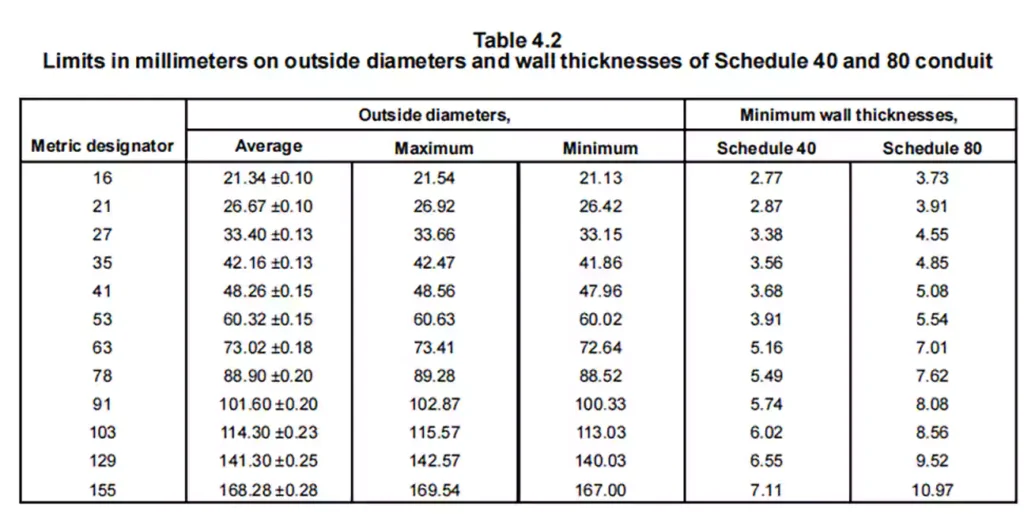

It sets specific dimensional requirement for PVC conduits of Schedule 40 and 80, and other types of rigid PVC conduit, from trade size 1/2” to 6”. Including outside diameter, wall thickness, minimum inside diameter, length and integral socket dimensions are measured to verify they fall within the specified tolerances.
Tensile Strength
This test is to confirm the conduit material can withstand pulling forces without failure, critical during cable pulling or stress.
Method: Standard specimens (dumbbell-shaped) cut from the conduit, aged and unaged, are pulled apart using a testing machine at a fixed rate of 10.0 ±2.5 mm per minute. This measures the maximum stress the material can endure before breaking.
Requirement: For Schedule 40 rigid PVC conduit, the tensile strength must not less than 5000 psi and maintain at least 95% strength after heat aging.
Water Absorption
Purpose: Ensures water uptake doesn’t degrade the conduit’s electrical or mechanical performance, especially for applications in moist environments.
Method: A sample is dried, weighed, then immersed in water at 23 °C for 24 hours. It is removed, dried on the surface, and reweighed.
Requirement: The weight gain due to water must be ≤0.50%.
Impact Resistance Test
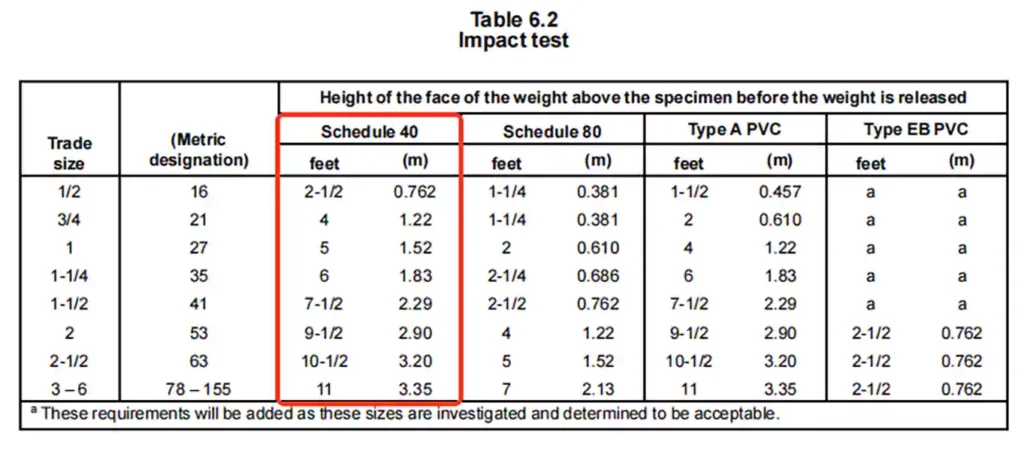
To evaluate the conduit’s ability to withstand mechanical shocks without cracking or tearing, ensuring durability during handling and installation.
Test Method: Ten specimens are conditioned at 23.0 ±2.0°C (73.4 ±3.6°F) for at least 4 hours.
And each Schedule 40 conduit specimen is subjected to a 20 lbs (9.1kg) impact force at a specific height.
Requirements: Seven out of ten specimen shall exhibit no cracks or tears longer than 1/32 inch (0.8 mm) along the outer surface.
Deflection Under Load Test
This test checks how well Schedule 40 PVC conduit resists bending when exposed to heat and mechanical stress.
Test Method: Specimens machined from finished conduit are supported at both ends and loaded in the center while submerged in a heated liquid. The temperature is gradually increased until the specimen bends (deflects) by 0.010 inch (0.25 mm).
Requirement: To pass, the average temperature at which this deflection occurs must be at least 70°C (158°F) under a light load (66 psi) and 62°C (143.6°F) under a heavier load (264 psi).
These results help confirm that the conduit will maintain its shape and strength in hot conditions, making it suitable for installations exposed to high temperatures.
Crush (Compression) Test
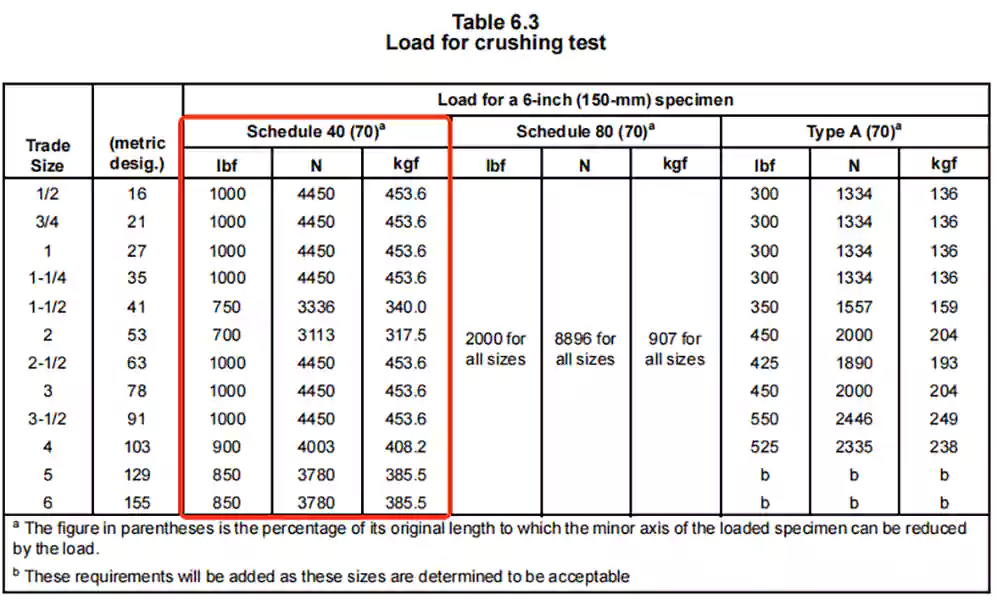
This test evaluates the ability of Schedule 40 PVC conduit to resist deformation under heavy external loads.
Method: A 6-inch section of conduit is placed between two flat steel plates and compressed at a steady rate. The goal is to simulate pressure the conduit might face when buried underground or installed under floors.
Requirement: To pass the test, the conduit must not buckle or pull away from the plates. After compression, the inner width (minor axis) of the flattened conduit must still be at least 70% of its original inner diameter. This ensures the conduit maintains its shape and allows space for wires even under load.
Flame Retardance Test
This test checks how well Schedule 40 PVC conduit resists catching fire and spreading flames.
Testing Method: An 18-inch vertical piece of conduit is exposed to a flame three times, each for 60 seconds, with a 30-second pause in between. Cotton is placed underneath to detect any burning particles or drips.
Requirement: To pass the test, the conduit must stop flaming within 5 seconds after each flame exposure. It must also not ignite the cotton below or around it, and it must not be completely consumed. This ensures the conduit won’t contribute to fire spread in real-world applications.
Resistance to Specific Reagents
This test evaluates the chemical resistance of Schedule 40 and Schedule 80 rigid PVC conduits when exposed to specific corrosive reagents. It includes two key components: the Reagent Absorption Test and the Crush Strength Test, which simulate long-term chemical exposure in environments where the conduit may be immersed or regularly contacted by aggressive substances such as oils, solvents, or chemicals.
- Test specimens (typically trade size 1 (27) or smaller) are immersed in a reagent at a defined temperature and concentration for 60 and 120 days.
- The Reagent Absorption Test measures the percentage of weight change to ensure it remains within acceptable limits (≤2.50%), and controls the rate of absorption over time to prevent excessive degradation.
- The Crush Strength Test compares the mechanical integrity of aged versus unaged specimens after exposure. It ensures the conduit retains at least 85% of its original crush strength and shows no structural failure such as cracking or collapsing.
This test is critical for confirming conduit performance in chemically aggressive installations and validates long-term durability for industrial and corrosive environments.
Sunlight Resistance Test (UV Test)
Purpose: PVC conduit systems are often installed in outdoor or exposed environments where they are subject to continuous ultraviolet (UV) radiation. This test evaluates the long-term UV resistance of Schedule 40 rigid PVC conduit when exposed to simulated sunlight and moisture.
Method: Samples are conditioned in a Xenon-arc weathering chamber for 720, 1080, and up to 1440 hours, followed by notched Izod impact testing in accordance with ASTM D256.
Requirement: Conduits must retain sufficient impact resistance after prolonged UV exposure to pass the test. Successful performance indicates that the product is suitable for sunlight-exposed applications and qualifies for the “Sunlight Resistant” designation.
This test is essential for verifying a conduit’s reliability in outdoor installations such as solar power systems, telecom infrastructure, and exposed electrical runs.
For Use with 90°C Wire
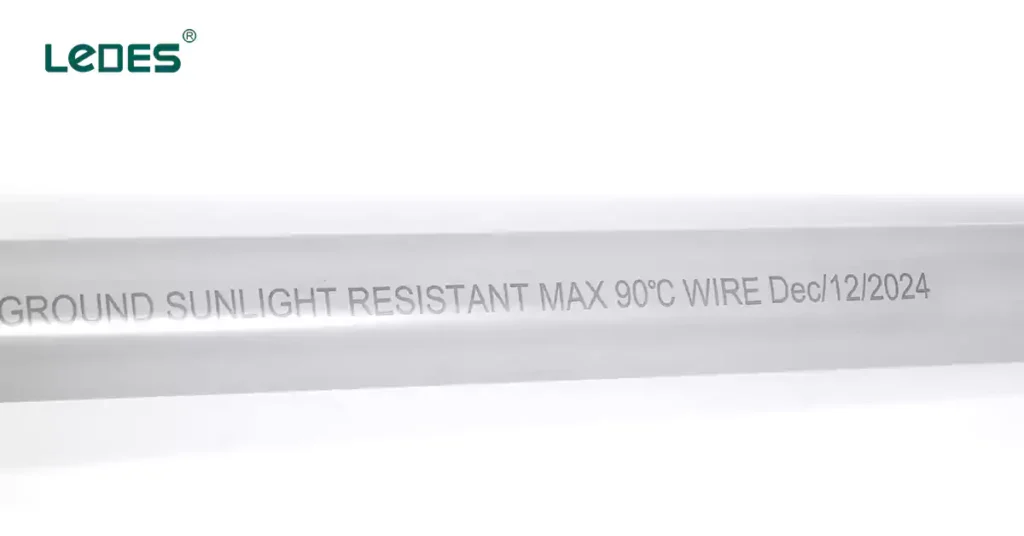
Schedule 40 (and Schedule 80) rigid PVC conduits are sometimes installed in environments where they must carry conductors rated for continuous operation at 90°C (194°F). To ensure the conduit material maintains integrity under long-term thermal stress, UL 651 requires a specialized test to verify that the conduit does not experience significant deterioration of its critical properties when exposed to elevated temperatures over time.
Testing Method: This test involves subjecting conduit samples to accelerated aging in a circulating-air oven at 80°C (176°F) for periods of up to 360 days. At intervals of 60, 120, 180, 240, and 360 days, specimens are removed, cooled, and evaluated for impact strength using a steel drop-weight test. The unaged specimens serve as a baseline, and the impact strength degradation is plotted over time.
Requirement: To pass the test, the impact strength must level off at no less than 50% of the value measured in the unaged samples. This ensures that the conduit retains sufficient mechanical integrity and impact resistance, even after prolonged exposure to high conductor temperatures.
Conduits that meet this requirement are marking with“maximum 90°C wire” or “max 90°C”, are reliable choice for high-performance and heat-intensive electrical systems.
Advantages & Disadvantages of Schedule 40 PVC Conduit
Schedule 40 PVC conduit is one of the most widely used types of electrical conduit across residential, commercial, and light industrial applications. Its popularity stems from a balance of performance, cost-effectiveness, and ease of use. However, like any material solution, it has its strengths and limitations. Understanding these advantages and disadvantages is essential for you to know whether it is suitable for your project environment.
6 Benefits of Schedule 40 PVC Conduit
Lightweight and Easy to Install
Schedule 40 PVC conduit is significantly lighter than Schedule 80 PVC conduit and metallic conduit systems, such as EMT or RMC. This reduces labor effort and installation time, especially in large-scale installations or overhead applications. Its lightweight nature also minimizes transportation and handling costs.
Corrosion-Resistant
One of the key advantages of PVC is its resistance to rust, rot, and chemical corrosion. Schedule 40 PVC conduit is ideal for damp or corrosive environments, including underground installations, agricultural settings, and wastewater facilities.
Cost-Effective
Compared to metal conduit systems, Schedule 40 PVC offers a lower upfront material cost and typically requires fewer specialized tools for installation. This makes it an economical choice for both small and large-scale electrical projects.
Non-Conductive and Electrically Insulating
PVC is inherently non-conductive, which eliminates the need for additional grounding in many applications. This characteristic enhances safety in environments where electrical shock risks must be minimized.
Weather and UV Resistant (with additives)
With proper UV stabilizers or when installed with appropriate coverings, Schedule 40 PVC can withstand sunlight exposure and outdoor conditions.
Good Chemical Resistance
Schedule 40 PVC exhibits strong resistance to a wide range of chemicals, including acids, salts, and alkalis. This characteristic makes it suitable for harsh industrial or chemical processing environments.
5 Disadvantages of Schedule 40 PVC Conduit
Lower Mechanical Strength
While adequate for many applications, Schedule 40 PVC has lower impact and crush resistance compared to Schedule 80 PVC or metallic conduit. It may not be suitable for environments with heavy traffic, mechanical abuse, or deep burial without additional protection.
Limited Temperature Range
PVC conduits typically perform well between -18°C (0°F) and 60°C (140°F), but can become brittle in extreme cold or soften in high-heat conditions. This limits its use in certain industrial or high-temperature installations.
Brittle in Cold Climates
In extremely cold temperatures, PVC becomes more brittle and prone to cracking. Installers must take care during handling and installation in sub-zero environments or consider alternative materials for such conditions.
Emits Smoke and Toxic Gases When Burning
Although PVC is self-extinguishing, it does emit smoke and potentially harmful gases when it burns. This is a disadvantage compared to Low Smoke Zero Halogen (LSZH) conduits or metal conduit, which offer better performance in fire-critical environments.
Susceptible to Thermal Expansion and Contraction
PVC expands and contracts more significantly than metal when exposed to temperature changes. If not properly compensated with expansion joints or design adjustments, this movement can lead to conduit displacement or joint stress over time.
Where Is Schedule 40 PVC Conduit Permitted?
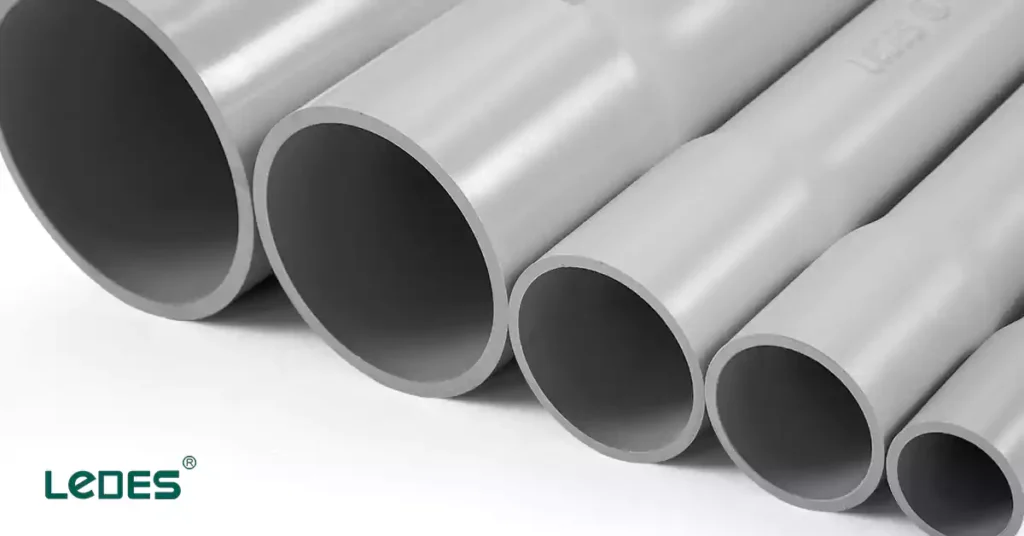
Schedule 40 PVC conduit is widely used in the market, and the National Electrical Code (NEC) provides comprehensive guidance on where it is allowed to be installed. NEC 352.10 specifies the places where Schedule 40 PVC conduit can be safely used.
Concealed Installations (Walls, Floors, Ceilings)
Schedule 40 PVC conduit is allowed to be hidden behind walls, under floors, and above ceilings in both residential and commercial buildings. Its low-profile and non-corrosive properties make it suitable for interior wiring systems that are not exposed to physical damage.
Encased in Concrete
It can be embedded directly within concrete slabs, beams, or walls. This is common in foundation work and underground duct banks, where the conduit is protected from the environment by the concrete enclosure.
Corrosive Environments
PVC conduit is particularly advantageous in highly corrosive locations—such as chemical plants, coastal areas, and wastewater facilities—where metal conduits would degrade quickly. The NEC allows PVC use in these environments as long as the material is rated for the specific chemicals present.
Cinder Fill Areas
PVC conduit can be installed in areas filled with industrial cinders or slag materials. These conditions can be highly corrosive, and PVC offers a non-reactive alternative to metal conduit systems.
Wet Locations (e.g., Dairies, Laundries, Car Washes)
PVC conduit is permitted in areas where moisture or wash-down conditions are routine. In such cases, installers must ensure the system is watertight—this includes using compatible PVC boxes, fittings, and corrosion-resistant hardware like stainless-steel screws or galvanized straps.
Dry and Damp Locations
It is suitable for general-purpose use in both dry and damp indoor environments, such as basements, storage rooms, and utility areas. The NEC permits PVC in these locations unless otherwise prohibited by specific rules outlined in NEC 352.12.
Exposed Installations
Schedule 40 PVC conduit may be installed in exposed configurations, such as along walls or ceilings in unfinished spaces. However, where there is potential for physical impact or mechanical stress, using Schedule 80 PVC is required for added protection.
Underground Installations
PVC conduit is widely used underground, either directly buried in soil or encased in concrete for extra mechanical protection. It is a common solution for service entrances, parking lots, and roadway lighting.
Insulation Temperature Compatibility
You can use conductors rated for higher temperatures inside PVC conduit, but they must not operate above the conduit’s rated temperature (typically 50°C or 60°C depending on the product). This protects the conduit from heat-related deformation or failure.
Schedule 40 PVC conduit can be used in many places, the key is to match the conduit type and installation method to the environment’s specific conditions. The NEC 352.12 has also specified the applications where it is not permitted, for more details, check the NEC for reference.
How Is Schedule 40 PVC Conduit Manufactured?
The manufacturing process of Schedule 40 PVC conduit is a carefully controlled industrial operation that ensures consistent product quality, compliance with standards, and long-term performance in electrical installations. Here’s a breakdown of the key 7 stages involved in producing this widely used nonmetallic conduit:
Raw Material Preparation
The main raw material used in Schedule 40 PVC conduit is polyvinyl chloride (PVC) resin, which is combined with various additives to enhance specific properties:
- Stabilizers: Prevent degradation during processing and extend thermal stability.
- Lubricants: Improve processability and reduce friction during extrusion.
- Impact Modifiers: Enhance the toughness and impact resistance of the final product.
- Pigments: Provide the typical gray color and protect against UV degradation when required.
- Fillers (e.g., calcium carbonate): Used to adjust mechanical properties and cost.
These ingredients are dry-blended into a homogeneous powder called compound or PVC formulation, which meets specific performance criteria, including flame resistance and mechanical strength.
Extrusion
The prepared compound is fed into a PVC extrusion machine, where the material is melted and formed into the shape of a conduit:
- The material is heated in a barrel with rotating screws to a molten state.
- It is then forced through a specially designed die head, which shapes it into a cylindrical pipe with a specific wall thickness suitable for Schedule 40.
- Vacuum sizing and cooling tanks downstream from the die help maintain tight dimensional tolerances as the pipe solidifies.
- The extrusion speed and cooling rate are carefully regulated to avoid deformation and ensure uniform wall thickness.
Cutting and Belling
Once the conduit is fully formed and cooled:
- It is cut to standard lengths, typically 10 or 20 feet.
- One end is belled (expanded) to allow for solvent welding during installation. The belling process uses a heated mold to flare the pipe end to fit the next section securely.
- The other end is kept plain (spigot).
Marking and Printing
Each conduit length is marked with mandatory information, typically through inkjet or hot-stamp printing. This includes:
Manufacturer name or trademark
Nominal size
Schedule designation (Schedule 40)
Relevant standards (e.g., UL 651)
Lot number and date of manufacture
Usage ratings (e.g., sunlight-resistant, if applicable)
Quality Control and Testing
Schedule 40 PVC conduit undergoes rigorous quality control checks, including:
Dimensional checks: To ensure inner and outer diameter meet standard tolerances.
Mechanical strength tests: To confirm the conduit can withstand mechanical stress without cracking.
Flame resistance tests: To verify that it meets fire safety requirements such as UL 94 V-0 or equivalent.
Marking durability: Ensures legibility remains during handling and storage.
Some manufacturers also perform infrared (IR), thermogravimetric analysis (TGA) or differential scanning calorimetry (DSC) tests to check compound consistency and ensure proper formulation across batches.
Packaging and Shipping
After passing inspection, the conduits are bundled and packaged using:
- Straps or plastic ties
- End caps to keep out dirt or moisture
- Labels for tracking and inventory
They are then loaded for shipment, often in pallets or crates for domestic or international distribution.
How to Install Schedule 40 PVC Conduit? (9 Steps)
Installing Schedule 40 PVC conduit requires careful planning, proper tools, and adherence to electrical codes to ensure a safe, durable, and compliant electrical system. Below is a professional overview of the general installation process.
Plan the Conduit Route
Before starting, review your layout to determine:
- The conduit path (above ground, underground, embedded in concrete, or concealed in walls).
- Entry and exit points for boxes, panels, and terminations.
- The number and type of bends and fittings required.
Refer to NEC fill tables to ensure the conduit size accommodates all intended conductors.
Cut and Prepare the Conduit
Use a fine-tooth saw, conduit cutter, or power miter saw to cut the conduit to the desired length.
Deburr and smoothen cut edges with a deburring tool or file to prevent wire insulation damage.
Apply Solvent Cement and Assemble
Dry-fit all components first to check alignment.
Clean both the conduit end and the fitting socket.
Apply an approved PVC solvent cement evenly to both the pipe and the fitting.
Quickly insert the conduit into the fitting with a slight twist to evenly distribute the cement.
Hold together until set.
Support the Conduit Properly
Secure conduit at intervals as required by code.
Use corrosion-resistant straps or clamps that are compatible with PVC material.
Accommodate Thermal Expansion
PVC expands and contracts with temperature changes. For long runs or outdoor installations:
Install expansion joints as recommended by the manufacturer.
Leave room for slight movement within fittings.
Make Bends with Heat (If Needed)
Use factory-made elbows when possible.
If custom bends are needed, apply uniform heat with a heat blanket or conduit heater.
Bend slowly and evenly, avoiding kinks or flattening.
Install Conduit into Boxes and Enclosures
Use terminal adapters, female adapters, or conduit bodies as needed.
Ensure tight, secure connections and proper gasket seals in wet or outdoor locations.
Pull Conductors
Once the conduit system is complete and fully cured:
Use a fish tape or pulling line to route the conductors.
Apply wire-pulling lubricant if needed to reduce friction.
Test and Inspect
Check for continuity, grounding (if applicable), and physical integrity.
Comply with local electrical inspection requirements before energizing the system.
Proper installation not only ensures code compliance but also extends the life of the conduit and protects wiring from damage.
7 Commons Fitting for Schedule 40 PVC Conduit
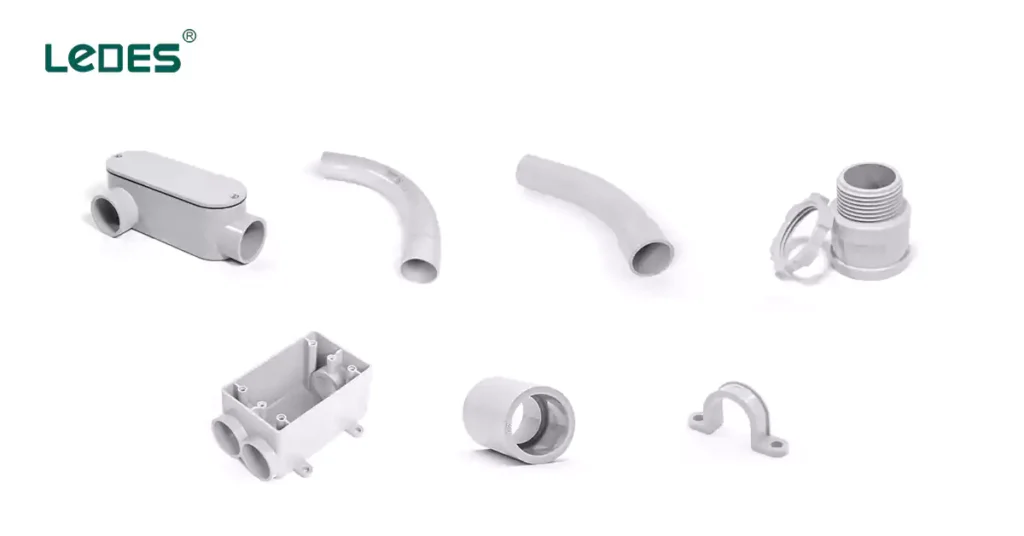
Fittings are essential components in any electrical conduit system. They allow Schedule 40 PVC conduit to connect, change direction, adapt to other systems, and safely terminate or support electrical wiring. Choosing the right fittings ensures a secure, code-compliant, and long-lasting installation. This section explores the most common types of fittings used with Schedule 40 PVC conduit, their applications, and installation considerations.
Conduit Couplings
Join two straight pieces of conduit end-to-end.
Types:
Standard Solvent Weld Couplings: Most common, joined with PVC cement.
Expansion Couplings: Designed to accommodate thermal expansion and contraction.
Conduit Elbows
Change the direction of conduit runs.
Bend Angles: 90°, 45°, 30°, 22.5°, and 11.25° are commonly available.
Types:
Standard Elbows: For general direction changes.
Sweep Elbows: Longer radius to ease wire pulling, often required for large or complex conduit runs.
Conduit Adapters
Transition from PVC conduit to boxes or other raceway systems.
Types:
Female Adapters: It transitions the conduit to a threaded connection, typically to attach to a threaded male fitting, electrical box, or enclosure.
Terminal Adapters: Connect to electrical boxes; often come with a threaded end and a locknut.
Electrical Boxes
Serve as junction points, pull points, or for housing electrical devices.
Types:
Junction Boxes: Available in square, round, or rectangular shapes.
Pull Boxes: Used to facilitate wire pulling in long conduit runs.
Device Boxes: Such as gang boxes, accommodate outlets, switches, and other fixtures.
Bushings and Caps
Bushings: Protect conductor insulation from abrasion at conduit ends.
End Caps: Seal unused conduit ends to prevent ingress of debris or moisture.
Straps and Clamps
Secure conduit runs to walls, ceilings, or other surfaces.
Materials: Corrosion-resistant plastic or metal; must support conduit without causing deformation.
Conduit Bodies (Type LB, LL, LR, T, etc.)
Provide access to wiring for pulling, splicing, or inspection.
Conduit bodies must be clearly marked and listed for use with PVC systems.
Material and Compatibility
All fittings used with Schedule 40 PVC conduit must:
- Be UL Listed or CSA Certified, depending on local code.
- Be made from compatible PVC material to ensure uniform thermal and mechanical behavior.
- Support the conduit size and Schedule 40 wall thickness (although many are also compatible with Schedule 80).
Joining Methods
Schedule 40 PVC conduit and fittings are typically joined using:
Solvent Welding: A chemical bond formed by applying primer and cement to both the conduit and fitting surfaces. This creates a strong, watertight, and permanent connection.
Threaded or Mechanical Connections: Used with adapters or transition fittings to interface with metal conduit, boxes, or equipment.
Installation Considerations
Expansion Control: Use expansion fittings where temperature variations could lead to conduit movement.
Support: Install support straps within NEC specified distances (usually within 3 ft of boxes and every 3 or up to 8 ft for horizontal runs).
Weather Exposure: For outdoor applications, use fittings labeled as UV-resistant or sunlight-resistant.
Sealing: In wet or underground locations, ensure fittings and boxes are properly sealed against moisture ingress.
Schedule 40 PVC Conduit vs. Schedule 40 PVC Pipe
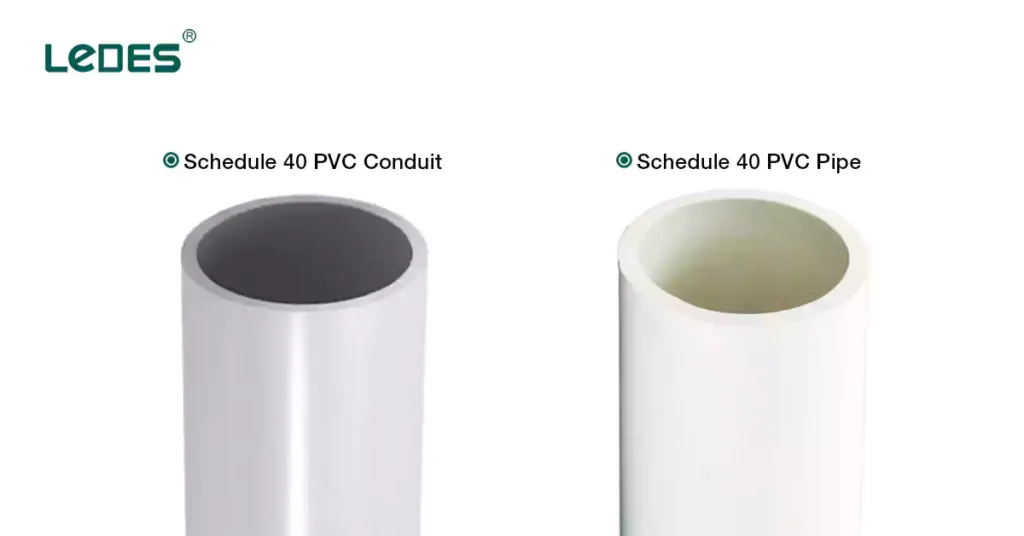
Although Schedule 40 PVC conduit and Schedule 40 PVC pipe look similar and even share the same outer diameter dimensions, they are not interchangeable and serve very different purposes. Understanding the key differences is essential for ensuring both code compliance and installation performance.
1. Application Purpose
Schedule 40 PVC Conduit is specifically designed for electrical wiring systems. It protects electrical cables from moisture, chemical exposure, and mechanical damage.
Schedule 40 PVC Pipe, on the other hand, is designed for plumbing systems, such as water supply, drainage, and irrigation.
2. Standards and Certifications
Conduit is manufactured according to UL 651 or NEMA TC-2 standards, meeting NEC (National Electrical Code) requirements.
Pipe typically complies with ASTM D1785, ASTM D2665 and NSF standards for potable water or drain/waste/vent (DWV) applications.
3. Wall Thickness and Strength
- While both have the same nominal Schedule 40 wall thickness, conduits are optimized for pull strength and easier wire pulling rather than water pressure.
- Pipes are pressure-rated for hydraulic performance and durability under sustained fluid flow.
4. Sunlight Resistance
Electrical conduit is often made with UV-resistant additives, making it suitable for outdoor exposed applications.
Plumbing pipe is not always UV-rated and can degrade over time if installed in direct sunlight without protection.
5. Fittings and Connections
Conduit fittings are designed to accommodate wiring systems and are generally solvent-welded or threaded. They may also have special features to prevent water ingress.
Pipe fittings are designed for fluid-tight seals and may include pressure-rated couplings, tees, and elbows specific to plumbing.
6. Fire Performance and Color
- Schedule 40 PVC conduit is often gray in color and must meet flame and smoke performance requirements for electrical applications.
- Schedule 40 PVC pipe is usually white, and fire resistance is not a standard requirement for plumbing systems.
Using PVC pipe in place of conduit for electrical installations is not permitted by the NEC. Doing so can result in code violations, safety hazards, and potential system failure.
Summary Table
Feature | Schedule 40 PVC Conduit | Schedule 40 PVC Pipe |
Purpose | Electrical wiring protection | Water/fluid transport |
Standards | UL 651, NEMA TC-2 | ASTM D1785, ASTM D2665, NSF |
UV Resistance | Often UV-rated | Usually not UV-rated |
Pressure Rating | Not pressure-rated | Pressure-rated |
Fire Resistance | Must meet NEC, UL fire standards | Not required |
Fittings | Designed for wire pulling systems | Designed for hydraulic sealing |
Color | Gray | White |
While Schedule 40 PVC conduit and pipe may look alike, they serve entirely different roles. For safe, compliant, and long-lasting electrical installations, always use Schedule 40 PVC conduit in accordance with NEC requirements—never substitute it with standard plumbing pipe.
Schedule 40 vs. Schedule 80 PVC Conduit (5 Different)
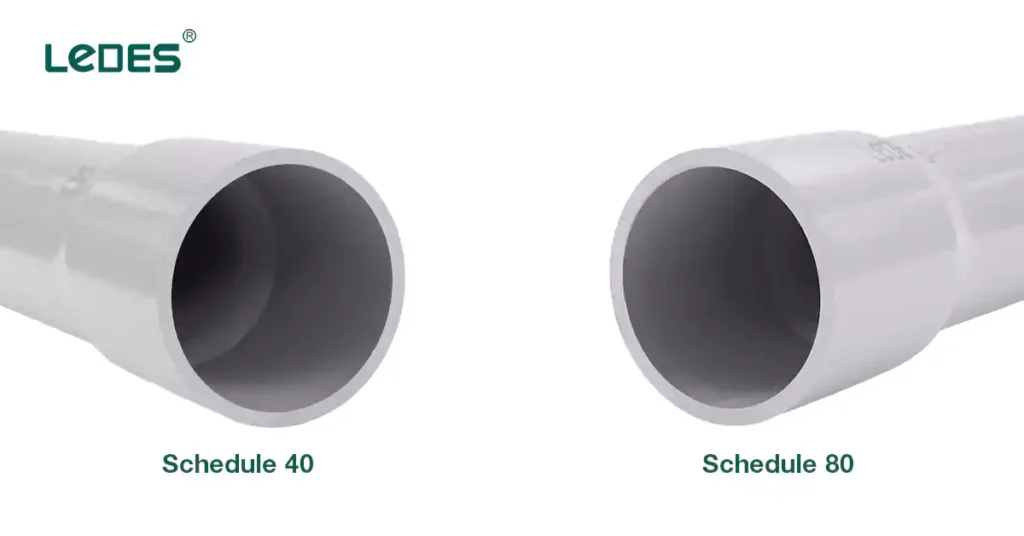
When choosing PVC conduit for an electrical installation, understanding the difference between Schedule 40 and Schedule 80 is crucial. Both types are widely used in residential, commercial, and industrial applications, but each has unique features, strengths, and code-specific uses. Below is a comprehensive comparison to help you select the right conduit for your project.
1. Wall Thickness and Strength
- Schedule 40 PVC Conduit has thinner walls, making it lighter and easier to handle and cut. It is ideal for above-ground or underground installations in areas where physical damage is unlikely.
- Schedule 80 PVC Conduit has thicker walls, offering greater mechanical strength and resistance to impact. This makes it better suited for environments with potential for physical damage or high traffic, such as exposed installations in industrial areas.
Inner Diameter (ID)
The outer diameter of both Schedule 40 and Schedule 80 conduit is the same, ensuring compatibility with fittings.
However, due to its thicker wall, Schedule 80 has a smaller inner diameter, which reduces wire-pulling space and can affect conduit fill calculations.
2. Fire and UV Resistance
Both Schedule 40 and 80 conduits are available with UV-resistant formulations and must meet NEC flame performance requirements.
Neither is inherently flameproof like metallic conduit, but they are self-extinguishing and designed to resist spreading flames.
3. Chemical and Corrosive Resistance
Both types are nonmetallic and corrosion-resistant, making them suitable for chemical environments.
Schedule 80 is often preferred in more aggressive or corrosive locations due to its added thickness and toughness.
4. Use in Physical Damage Areas
According to NEC 352.10(K), Schedule 80 must be used “where subject to physical damage,” such as:
Exposed outdoor installations
Warehouses or factory floors
Locations with frequent equipment movement
5. Weight and Installation
Schedule 40 is easier to work with due to its lightweight and flexibility, reducing labor costs for large installations.
Schedule 80, while stronger, is heavier and more rigid, which can require more effort to cut, bend, and secure.
Comparison Table
Feature | Schedule 40 PVC Conduit | Schedule 80 PVC Conduit |
Standards | UL 651, NEMA TC-2 | UL 651, NEMA TC-2 |
Wall Thickness | Thinner | Thicker |
Weight | Lighter | Heavier |
Inner Diameter | Larger (more wire space) | Smaller (less wire space) |
Mechanical Strength | Moderate | High |
Cost | Lower | Higher |
Installation | Easier to cut and bend | Harder to work with |
Choosing between Schedule 40 and Schedule 80 PVC conduit comes down to the environment and application demands. For most standard electrical work, Schedule 40 is sufficient. However, when installation sites demand higher impact resistance or face harsher conditions, Schedule 80 is the safer and code-compliant choice.
Ledes Schedule 40 PVC Conduit Solutions
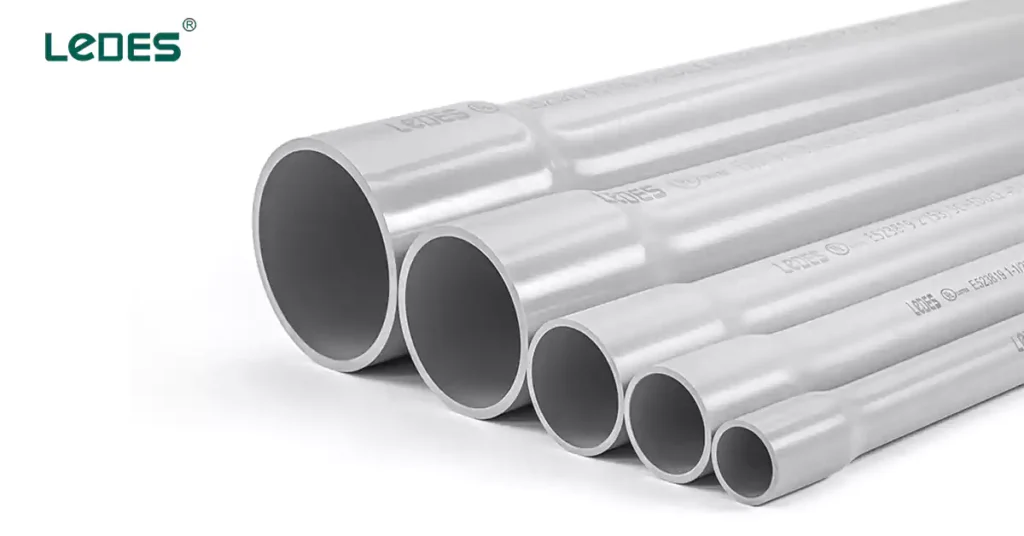
As a professional electrical conduit products manufacturer, Ledes offers a premium line of Schedule 40 PVC conduit solutions designed to meet the demands of residential, commercial, industrial, and infrastructure projects. Built for durability, easy installation, and environmental resistance, Ledes Schedule 40 PVC conduits are trusted by electricians and contractors worldwide.
Product Features
- Standard Trade Sizes: 1/2″ through 6″ available.
- Bell-end design for easy solvent-welding installation.
- High impact resistance and crush strength for tough environments.
- Smooth inner wall for easy cable pulling and reduced friction.
Engineered to Perform
Ledes Schedule 40 PVC conduit is manufactured from high-quality, rigid polyvinyl chloride (PVC) materials that are:
- Corrosion-resistant, ideal for use in wet, damp, and underground environments.
- Non-conductive, ensuring safe isolation of electrical conductors.
- UV-resistant, with added stabilizers for superior outdoor performance.
- Fire-retardant, formulated to meet UL 651 standards for flame resistance.
Code-Compliant and Certified
Ledes conduits are rigorously tested to comply with international and regional standards:
- UL 651 Listed for rigid PVC conduit and fittings.
- NEMA TC-2 compliant, meeting dimensional and performance specifications.
- Compliant with NEC Article 352 for rigid PVC conduit use.
Comprehensive Conduit Systems
Ledes doesn’t just stop at conduit. To provide a full installation solution, they offer:
- Compatible Schedule 40 fittings, including couplings, elbows, adapters, boxes, and more.
- Custom lengths and packaging options for large-scale projects or distribution.
Why Choose Ledes?
Choosing Ledes means choosing:
Certified quality
Proven performance
Global availability
Expert technical support
Whether you’re wiring a new home, upgrading a commercial facility, or building infrastructure for the future, Ledes Schedule 40 PVC conduit solutions offer the reliability and compliance your project demands.
PVC Conduit Buying Guide and Expert Advice
Choosing the right Schedule 40 PVC conduit isn’t just about picking a size—it involves evaluating compliance, compatibility, project needs, and supplier reliability. This guide breaks down what to consider before making a purchase, ensuring you get the right product for your electrical infrastructure.
8 Key Considerations Before Buying
1. Conduit Size (Diameter)
Choose the correct nominal trade size (e.g., ½”, ¾”, 1″, 2″) based on the number and type of conductors.
Follow NEC conduit fill tables and ensure adequate space for pulling and heat dissipation.
2. Wall Thickness
Ensure it’s Schedule 40 wall thickness as required—provides the appropriate strength for most residential and light commercial applications.
For areas subject to physical damage, consider upgrading to Schedule 80.
3. Compliance with Standards
Verify that the conduit is UL Listed (UL 651) or CSA certified, and meets NEC Article 352.
Check compliance with regional standards if outside North America
4. Material Quality
Use high-quality, virgin or certified reprocessed PVC materials.
Look for chemical resistance, UV resistance (if exposed outdoors), and heat tolerance.
5. Project Quantity Estimation
Calculate the total linear footage needed, including extra length for bends and waste.
Don’t forget accessories like couplings, adapters, and boxes.
6. Fittings Compatibility
Ensure fittings (elbows, adapters, boxes) are listed for use with Schedule 40 PVC conduit.
7. Transportation and Handling
Plan for safe transportation—PVC can be damaged by improper loading or impact.
Store in a dry, shaded area to prevent UV degradation and warping.
8. Reputable Brands and Manufacturers
Choose products from well-established manufacturers with quality control, technical documentation, and support.
Consider availability of compatible accessories and fittings.
Expert Advice
Tip 1: Don’t Mix Pipe and Conduit
Even if Schedule 40 PVC pipe and conduit look similar, PVC water pipe is not electrically rated. Use only UL-listed conduit for wire runs.
Tip 2: Plan for Expansion
PVC expands and contracts with temperature changes. Use expansion couplings in long runs, especially outdoors.
Tip 3: Use Primer and Solvent Cement for Watertight Seals
In wet or underground environments, follow best practices for gluing joints. Allow cure time before burial or pulling wires.
Tip 4: Match Temperature Ratings
Conductors must not exceed the maximum temperature rating of the PVC conduit—typically 90°C (194°F).
Conclusion
Schedule 40 PVC conduit stands out as one of the most widely used electrical conduit solutions in both residential and commercial applications. Its blend of durability, corrosion resistance, ease of installation, and cost-effectiveness makes it a trusted choice for protecting electrical wiring across a variety of environments—from underground systems to interior walls and exposed outdoor runs.
Throughout this guide, we’ve explored its core features, relevant NEC code permissions, manufacturing processes, fittings, and comparisons with other types like Schedule 80 and standard PVC pipe. We’ve also covered essential buying tips and practical installation guidelines to help ensure your project is both safe and compliant.
As with any electrical infrastructure product, choosing the right conduit involves more than just picking a size—it’s about understanding performance needs, environmental conditions, and code requirements. Whether you’re a contractor, builder, or engineer, Schedule 40 PVC conduit offers a flexible, reliable solution that continues to evolve with modern building demands.
FAQs
What is Schedule 40 PVC Conduit used for?
Schedule 40 PVC conduit is primarily used to protect and route electrical wiring in residential, commercial, and industrial applications. It is suitable for both above-ground and underground installations, including use in walls, ceilings, floors, direct burial, and concrete encasement. It’s also approved for wet and corrosive environments when installed with compatible fittings.
What is Schedule 40 PVC Pipe used for?
Schedule 40 PVC pipe is typically used for plumbing applications, such as potable water distribution, irrigation, and drainage systems. While it may appear similar to conduit, it is designed for fluid transport and is not rated for electrical use.
Can Schedule 40 PVC be buried?
Yes, Schedule 40 PVC conduit is approved for direct burial and for encasement in concrete, provided it is installed according to NEC Article 352 and local codes. However, in areas subject to physical damage, Schedule 80 may be required.
How deep should a PVC conduit be under concrete?
Generally, non-metallic conduit require 24 inches burial depth, if under concrete slabs in commercial or industrial settings must typically be buried at least 18 inches deep. Depth requirements may vary based on voltage, location, and traffic load, so always confirm with local code officials.
Can you mix Schedule 40 and Schedule 80 PVC?
Yes, Schedule 40 and 80 PVC conduit can be connected together using standard fittings, as both types have the same outer diameter. However, they have different wall thicknesses and strength ratings, so mixing them should be done cautiously and typically only when transitioning between areas with different protection requirements.
Can you use Schedule 40 PVC for electrical wiring?
Only Schedule 40 PVC conduit (marked and listed for electrical use) can be used for electrical installations. Regular Schedule 40 PVC pipe used for plumbing should not be used as a substitute for conduit, as it does not meet the flame and smoke requirements of electrical codes.
How to bend Schedule 40 PVC Conduit?
Schedule 40 PVC conduit can be bent using a heat source, such as a heat gun or a specialized PVC heating blanket. Once softened, it can be shaped using a bending form or guide. It must be cooled in position to maintain its shape. But avoid overheating.
How long does Schedule 40 PVC conduit last?
When properly installed and protected from extreme UV exposure or mechanical damage, Schedule 40 PVC conduit can last 50 years or more. Its resistance to corrosion, moisture, and chemicals makes it highly durable in most environments.
What is the difference between white PVC and grey PVC?
White PVC is typically used for plumbing and water systems and is not rated for electrical use.
Grey PVC is specifically manufactured for electrical applications, is UV-resistant, and complies with UL and NEC requirements for flame retardance and insulation.



